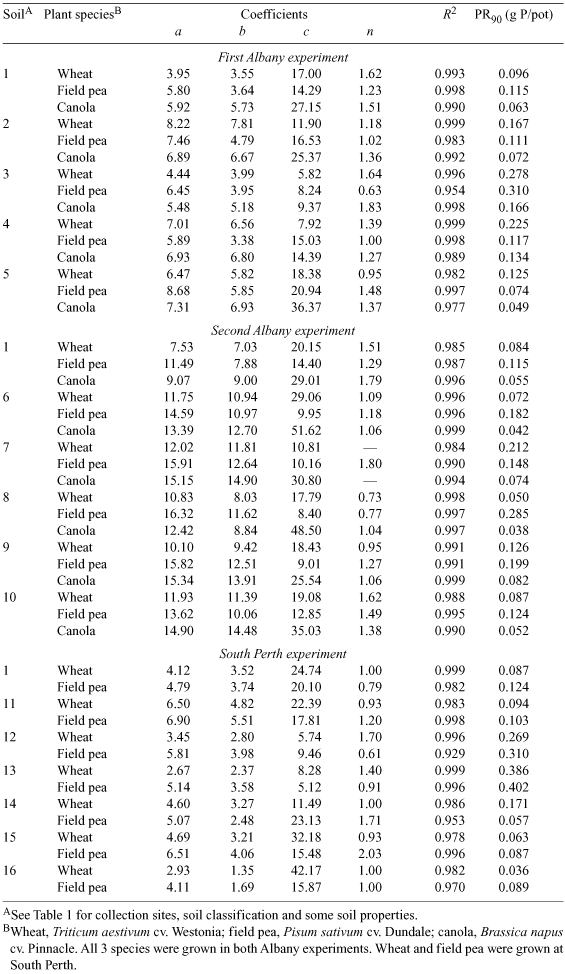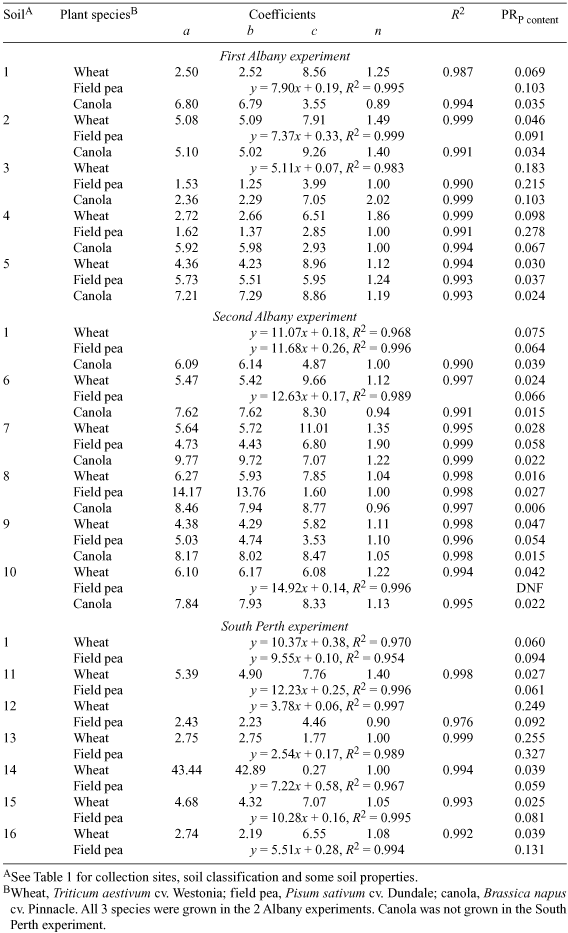Comparing responses to phosphorus of field pea (Pisum sativum), canola (rape, Brassica napus) and spring wheat (Triticum aestivum)
M. D. A. Bolland A B E , R. F. Brennan C and P. F White DA Department of Agriculture, PO Box 1231, Bunbury, WA 6231, Australia.
B School of Plant Biology, The University of Western Australia, 35 Stirling Highway, Crawley, WA 6009, Australia.
C Department of Agriculture, 444 Albany Highway, Albany, WA 6330, Australia.
D Department of Agriculture, Locked Bag 4, Bentley Delivery Centre, WA 6983, Australia.
E Corresponding author. Email: mbolland@agric.wa.gov.au
Australian Journal of Experimental Agriculture 46(5) 645-657 https://doi.org/10.1071/EA03276
Submitted: 20 December 2003 Accepted: 17 September 2004 Published: 12 May 2006
Abstract
The phosphorus (P) requirements of spring wheat (Triticum aestivum L.) are well known for all soils in south-western Australia; but the P requirements of field pea (Pisum sativum L.) and canola (Brassica napus L.), which are grown in rotation with wheat on marginally acidic to alkaline soils in the region, are not known. In a glasshouse study, the P requirements of field pea and wheat were compared for 16 soils collected throughout the agricultural region. Ten of the 16 soils were also used to compare the P requirements of canola and wheat. The P was applied as powdered single superphosphate, and yield of dried shoots of 42-day-old plants was measured. The amount of P required to produce 90% of the maximum yield of dried shoots (PR90 values) was used to compare the P requirements of the species. To produce 90% of the maximum yield, field pea required less P than wheat in 5 soils, similar P in 2 soils, and more P in 9 soils. Canola required less P than wheat in all 10 soils. We conclude the P requirements of field pea or canola relative to wheat depend on a complex interaction between plant and soil, particularly for field pea relative to wheat. Per unit of applied P, the P concentration in dried shoots decreased in the order canola > wheat > field pea, indicating the order in which plant roots of the 3 species were able to access P from soil.
Acknowledgments
Technical assistance was provided by Frank O’Donnell for the 2 Albany experiments and by Mike Baker for the South Perth experiment. Funds were provided by the Pulse and Oilseed programs of the Western Australian Department of Agriculture. The Chemistry Centre (WA) measured soil properties and P concentration in dried shoots. Comments and suggestions of Dr N. J. Barrow greatly improved our paper.
Barrow NJ
(1977) Phosphorus uptake and utilisation by tree seedlings. Australian Journal of Botany 25, 571–584.
| Crossref | GoogleScholarGoogle Scholar |

Barrow NJ, Mendoza RE
(1990) Equations for describing sigmoid yield responses and their application to some phosphate responses by lupins and subterranean clover. Fertilizer Research 22, 181–188.
| Crossref | GoogleScholarGoogle Scholar |

Bolland MDA
(1997) The comparative phosphorus requirement of canola (Brassica napus) and wheat (Triticum aestivum). Journal of Plant Nutrition 20, 813–829.

Bolland MDA
(1999) Comparing canola and wheat seedling use of different sources of phosphorus. Journal of Plant Nutrition 22, 1197–1210.

Bolland MDA, Gilkes RJ
(2004) The systematic effect of soil P buffer capacity on Colwell soil P test versus plant response calibration only exists when field experiments are adjacent. Australian Journal of Soil Research 42, 763–766.
| Crossref |

Brennan RF, Bolland MDA
(2001) Comparing fertiliser phosphorus requirements of canola, lupin and wheat. Journal of Plant Nutrition 24, 1885–1900.
| Crossref | GoogleScholarGoogle Scholar |

Brewster JL,
Bhat KS, Nye PH
(1976) The possibility of predicting solute uptake and plant growth response from independently measured soil and plant characteristics. IV. The growth and uptake of rape in solution of different phosphorus concentrations. Plant and Soil 44, 279–293.
| Crossref | GoogleScholarGoogle Scholar |

Burgess SJ
(1988) Going beyond single-figure fertiliser recommendations. Journal of the Department of Agriculture of Western Australia [4th series] 29, 12–16.

Foehse D, Jungk A
(1983) Influence of phosphate and nitrate supply on root hair formation of rape, spinach, and tomato plants. Plant and Soil 74, 359–369.
| Crossref | GoogleScholarGoogle Scholar |

Gerdemann JW
(1968) Vesicular-arbuscular mycorrhizae and plant growth. Annual Review of Phytopathology 6, 397–418.
| Crossref | GoogleScholarGoogle Scholar |

Grinstead MJ,
Hedley MJ,
White RE, Nye PH
(1982) Plant induced changes in the rhizosphere of rape (Brassica napus var. Emerald) seedlings. I. pH change and the increase in P concentration in the soil solution. New Phytologist 91, 19–29.
| Crossref |

Haynes RJ
(1992) Relative ability of a range of crop species to use phosphate rock and monocalcium phosphate as P sources when grown in soil. Journal of the Science of Food and Agriculture 60, 205–211.

Hoffland E,
Findenegg GR, Nelemans JA
(1989a) Solubilisation of rock phosphate by rape. II. Local root exudation of organic acids as a response to P-starvation. Plant and Soil 113, 161–165.
| Crossref | GoogleScholarGoogle Scholar |

Hoffland E,
Findenegg GR, Nelemans JA
(1989b) Solubilisation of rock phosphate by rape. I. Evaluation of the role of the nutrient uptake pattern. Plant and Soil 113, 155–160.
| Crossref | GoogleScholarGoogle Scholar |

McKenzie HA, Wallace HS
(1954) Kjeldahl determination of nitrogen. Australian Journal of Chemistry 7, 55–70.

Moorby H,
White RE, Nye PH
(1988) The influence of phosphate nutrition on H+ efflux from roots of young rape plants. Plant and Soil 105, 247–256.
| Crossref |

Nelder JA, Mead R
(1965) A simplex method for function minimisation. Computer Journal 7, 31–36.

Nuruzzaman M,
Lambers H,
Bolland MDA, Veneklaas EJ
(2005) Phosphorus benefits of different legume crops to subsequent wheat grown in different soils of Western Australia. Plant and Soil 271, 175–187.
| Crossref |

Ozanne PG, Shaw TC
(1967) Phosphate sorption by soils as a measure of the phosphate requirement for pasture growth. Australian Journal of Agricultural Research 18, 601–612.
| Crossref | GoogleScholarGoogle Scholar |

Veneklaas EJ,
Stevens J,
Cathray GR,
Turner S,
Grigg AM, Lambers H
(2003) Chickpea and white lupin rhizosphere carboxylates vary with soil properties and enhance phosphorus uptake. Plant and Soil 248, 187–197.
| Crossref | GoogleScholarGoogle Scholar |

Walkley A, Black IA
(1934) An examination of the Degtjareff method of determining soil organic matter and a proposed modification of the chromic acid titration method. Soil Science 37, 29–38.

Yuen SH, Pollard AG
(1954) Determination of nitrogen in agricultural materials by the Nessler Reagent. II. Micro-determination of plant tissue and soil extracts. Journal of the Science of Food and Agriculture 5, 364–369.


|

|


